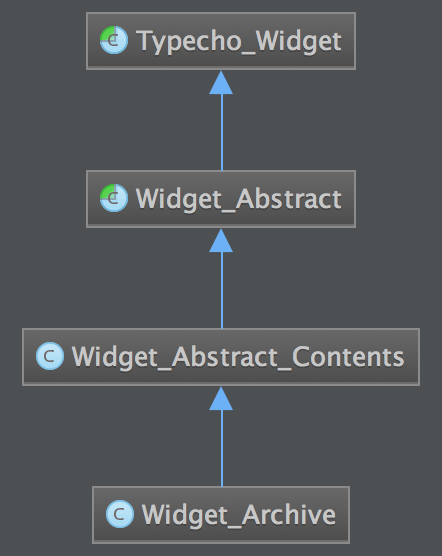这篇我们就讲讲首页的业务逻辑,首先我们看看路由。
[index] => Array
(
[url] => /
[widget] => Widget_Archive
[action] => render
[regx] => |^[/]?$|
[format] => /
[params] => Array
(
)
)
由路由表中的正则表达式我们能看出首页的URL为https://blog.phpgao.com/或http://www.phpgao.com,并且不接受任何参数。
下面我们找到了Widget_Archive类,让我们先看看这个类的继承关系(其中Typecho_Widget和Widget_Abstract为抽象类):

由上一节我们可以得到结论,当路由表匹配到/,会实例化Widget_Archive类,他位于var/Widget/Archive.php,其方法为render。
下面我们一步步跟进,看看到底发生了些什么?
再深入之前,我们需要有一些基本的概念,在此需要讲清楚,便于理解typecho的设计模式:
- 基类Typecho_Widget
该类位于var/Typecho/Widget.php,是var/Widget文件夹下所有类的基类,也就是说,几乎所有与业务有关的功能,就是继承此类。
纵观此类,方法不是很多,老高在此挑几个重要的讲解:
/**
* 获取对象插件句柄
* 此方法为插件的实现提供了快捷的语法
*/
public function pluginHandle($handle = NULL)
{
return Typecho_Plugin::factory(empty($handle) ? get_class($this) : $handle);
}
/**
* 将类本身赋值
* 模板中很常见,将自己复制给某一个变量,在调用next()方法循环输出
*/
public function to(&$variable)
{
return $variable = $this;
}
/**
* 将每一行的值压入堆栈
* 把数据放到自己的'肚子'里
*/
public function push(array $value)
{
//将行数据按顺序置位
$this->row = $value;
$this->length ++;
$this->stack[] = $value;
return $value;
}
/**
* 返回堆栈每一行的值
* 有点像从数据库中循环读取结果集
* 与push相对应,值得大家参考
*/
public function next()
{
if ($this->stack) {
$this->row = @$this->stack[key($this->stack)];
next($this->stack);
$this->sequence ++;
}
if (!$this->row) {
reset($this->stack);
if ($this->stack) {
$this->row = $this->stack[key($this->stack)];
}
$this->sequence = 0;
return false;
}
return $this->row;
}
# 魔术方法,当调用一个不存在的方法时触发,输出当前$this->name的属性值。
public function __call($name, $args)
# 魔术方法,当获取不存在的属性时,首先会在$this->row中寻找,如果未找到,则调用___name()方法,并将结果返回,如果还是不存在,就以name为挂载点,触发插件事件,并返回结果。
public function __get($name)
public function __set($name, $value)
码字不易,转载请注明出处。